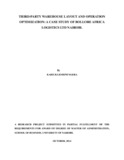| dc.description.abstract | The third party warehouse practice in Kenya is increasingly growing as firms in Kenya
adopt new management philosophies such as Just In Time
(JIT), lean, agile, cross
docking, e
-
commerce and globalization. Third party warehouses are therefore looking
for ways to optimize operations so that to add value to the customers as well as maintain
competitive advantage. The objectives of the study were:
To establish the storage
optimization strategies currently employed by third party warehouses in Nairobi; to
investigate the relationship between warehouse storage strategies and the level of
optimization and to investigate the challenges therein. A case
study was carried out in
Bollore Africa logistics limited Nairobi where a response rate of 75% was achieved.
The analysis was carried out using descriptive statistics, ratios and correlation analysis.
The research found that majority of the warehouses used
random storage, mechanical
devices and casual labour to optimize their operations. The research also found a strong
positive relationship between level of optimization and storage system adopted.
Research further found that the warehouse adopting random s
torage system had higher
space utilization than those using dedicated or class based storage system. Similarly,
labour productivity was found to be low in warehouses using random storage compared
to those with dedicated or class based storage system. The r
esearch concluded that the
random storage guarantee high level of storage space utilization as opposed to the use of
class based and dedicated storage design while the dedicated and class based system
guarantee high level of labour productivity compared to
random storage. The research
therefore recommended that third party warehouse should decide on the two trade
-
offs;
Time and space, depending on their constraints and adopt the storage strategy that offers
the highest optimization. The study was however co
nducted on a short span of time and
data collected on one organization. The study recommended that further study should be
done on a time series approach as well as in other organisations and findings compared
to validate the findings | en_US |

